#>anti-poaching
Explore tagged Tumblr posts
Text
Nurses whose shitty boss is a shitty app

If you'd like an essay-formatted version of this post to read or share, here's a link to it on pluralistic.net, my surveillance-free, ad-free, tracker-free blog:
https://pluralistic.net/2024/12/17/loose-flapping-ends/#luigi-has-a-point

Operating a business is risky: you can't ever be sure how many customers you'll have, or what they'll show up looking for. If you guess wrong, you'll either have too few workers to serve the crowd, or you'll pay workers to stand around and wait for customers. This is true even when your "business" is a "hospital."
Capitalists hate capitalism. Capitalism is defined by risk – like the risk of competitors poaching your customers and workers. Capitalists all secretly dream of a "command economy" in which other people have to arrange their affairs to suit the capitalists' preferences, taking the risk off their shoulders. Capitalists love anti-competitive exclusivity deals with suppliers, and they really love noncompete "agreements" that ban their workers from taking better jobs:
https://pluralistic.net/2023/04/21/bondage-fees/#doorman-building
One of the sleaziest, most common ways for capitalists to shed risk is by shifting it onto their workers' shoulders, for example, by sending workers home on slow days and refusing to pay them for the rest of their shifts. This is easy for capitalists to do because workers have a collective action problem: for workers to force their bosses not to do this, they all have to agree to go on strike, and other workers have to honor their picket-lines. That's a lot of chivvying and bargaining and group-forming, and it's very hard. Meanwhile, the only person the boss needs to convince to screw you this way is themself.
Libertarians will insist that this is impossible, of course, because workers will just quit and go work for someone else when this happens, and so bosses will be disciplined by the competition to find workers willing to put up with their bullshit. Of course, these same libertarians will tell you that it should be legal for your boss to require you to sign a noncompete "agreement" so you can't quit and get a job elsewhere in your field. They'll also tell you that we don't need antitrust enforcement to prevent your boss from buying up all the businesses you might work for if you do manage to quit.
In practice, the only way workers have successfully resisted being burdened with their bosses' risks is by a) forming a union, and then b) using the union to lobby for strong labor laws. Labor laws aren't a substitute for a union, but they are an important backstop, and of course, if you're not unionized, labor law is all you've got.
Enter the tech-bro, app in hand. The tech-bro's most absurd (and successful) ruse is "it's not a crime, I did it with an app." As in "it's not money-laundering, I did it with an app." Or "it's not a privacy violation, I did it with an app." Or "it's not securities fraud, I did it with an app." Or "it's not price-gouging, I did it with an app," or, importantly, "it's not a labor-law violation, I did it with an app."
The point of the "gig economy" is to use the "did it with an app" trick to avoid labor laws, so that bosses can shift risks onto workers, because capitalists hate capitalism. These apps were first used to immiserate taxi-drivers, and this was so successful that it spawned a whole universe of "Uber for __________" apps that took away labor rights from other kinds of workers, from dog-groomers to carpenters.
One group of workers whose rights are being devoured by gig-work apps is nurses, which is bad news, because without nurses, I would be dead by now.
A new report from the Roosevelt Institute goes deep on the way that nurses' lives are being destroyed by gig work apps that let bosses in America's wildly dysfunctional for-profit health care industry shift risk from bosses to the hardest-working group of health care professionals:
https://rooseveltinstitute.org/publications/uber-for-nursing/
The report's authors interviewed nurses who were employed through three apps: Shiftkey, Shiftmed and Carerev, and reveal a host of risk-shifting, worker-abusing practices that has nurses working for so little that they can't afford medical insurance themselves.
Take Shiftkey: nurses are required to log into Shiftkey and indicate which shifts they are available for, and if they are assigned any of those shifts later but can't take them, their app-based score declines and they risk not being offered shifts in the future. But Shiftkey doesn't guarantee that you'll get work on any of those shifts – in other words, nurses have to pledge not to take any work during the times when Shiftkey might need them, but they only get paid for those hours where Shiftkey calls them out. Nurses assume all the risk that there won't be enough demand for their services.
Each Shiftkey nurse is offered a different pay-scale for each shift. Apps use commercially available financial data – purchased on the cheap from the chaotic, unregulated data broker sector – to predict how desperate each nurse is. The less money you have in your bank accounts and the more you owe on your credit cards, the lower the wage the app will offer you. This is a classic example of what the legal scholar Veena Dubal calls "algorithmic wage discrimination" – a form of wage theft that's supposedly legal because it's done with an app:
https://pluralistic.net/2023/04/12/algorithmic-wage-discrimination/#fishers-of-men
Shiftkey workers also have to bid against one another for shifts, with the job going to the worker who accepts the lowest wage. Shiftkey pays nominal wages that sound reasonable – one nurse's topline rate is $23/hour. But by payday, Shiftkey has used junk fees to scrape that rate down to the bone. Workers have to pay a daily $3.67 "safety fee" to pay for background checks, drug screening, etc. Nevermind that these tasks are only performed once per nurse, not every day – and nevermind that this is another way to force workers to assume the boss's risks. Nurses also pay daily fees for accident insurance ($2.14) and malpractice insurance ($0.21) – more employer risk being shifted onto workers. Workers also pay $2 per shift if they want to get paid on the same day – a payday lending-style usury levied against workers whose wages are priced based on their desperation. Then there's a $6/shift fee nurses pay as a finders' fee to the app, a fee that's up to $7/shift next year. All told, that $23/hour rate cashes out to $13/hour.
On top of that, gig nurses have to pay for their own uniforms, licenses, equipment and equipment, including different colored scrubs and even shoes for each hospital. And because these nurses are "their own bosses" they have to deduct their own payroll taxes from that final figure. As "self-employed" workers, they aren't entitled to overtime or worker's comp, they get no retirement plan, health insurance, sick days or vacation.
The apps sell themselves to bosses as a way to get vetted, qualified nurses, but the entire vetting process is automated. Nurses upload a laundry list of documents related to their qualifications and undergo a background check, but are never interviewed by a human. They are assessed through automated means – for example, they have to run a location-tracking app en route to callouts and their reliability scores decline if they lose mobile data service while stuck in traffic.
Shiftmed docks nurses who cancel shifts after agreeing to take them, but bosses who cancel on nurses, even at the last minute, get away at most a small penalty (having to pay for the first two hours of a canceled shift), or, more often, nothing at all. For example, bosses who book nurses through the Carerev app can cancel without penalty on a mere two hours' notice. One nurse quoted in the study describes getting up at 5AM for a 7AM shift, only to discover that the shift was canceled while she slept, leaving her without any work or pay for the day, after having made arrangements for her kid to get childcare. The nurse assumes all the risk again: blocking out a day's work, paying for childcare, altering her sleep schedule. If she cancels on Carerev, her score goes down and she will get fewer shifts in the future. But if the boss cancels, he faces no consequences.
Carerev also lets bosses send nurses home early without paying them for the whole day – and they don't pay overtime if a nurse stays after her shift ends in order to ensure that their patients are cared for. The librarian scholar Fobazi Ettarh coined the term "vocational awe" to describe how workers in caring professions will endure abusive conditions and put in unpaid overtime because of their commitment to the patrons, patients, and pupils who depend on them:
https://www.inthelibrarywiththeleadpipe.org/2018/vocational-awe/
Many of the nurses in the study report having shifts canceled on them as they pull into the hospital parking lot. Needless to say, when your shift is canceled just as it was supposed to start, it's unlikely you'll be able to book a shift at another facility.
The American healthcare industry is dominated by monopolies. First came the pharma monopolies, when pharma companies merged and merged and merged, allowing them to screw hospitals with sky-high prices. Then the hospitals gobbled each other up, merging until most regions were dominated by one or two hospital chains, who could use buyer power to get a better deal on pharma prices – but also use seller power to screw the insurers with outrageous prices for care. So the insurers merged, too, until they could fight hospital price-gouging.
Everywhere you turn in the healthcare industry, you find another monopolist: pharmacists and pharmacy benefit managers, group purchasing organizations, medical beds, saline and supplies. Monopoly begets monopoly.
(Unitedhealthcare is extraordinary in that its divisions are among the most powerful players in all of these sectors, making it a monopolist among monopolists – for example, UHC is the nation's largest employer of physicians:)
https://www.thebignewsletter.com/p/its-time-to-break-up-big-medicine
But there two key stakeholders in American health-care who can't monopolize: patients and health-care workers. We are the disorganized, loose, flapping ends at the beginning and end of the healthcare supply-chain. We are easy pickings for the monopolists in the middle, which is why patients pay more for worse care every year, and why healthcare workers get paid less for worse working conditions every year.
This is the one area where the Biden administration indisputably took action, bringing cases, making rules, and freaking out investment bankers and billionaires by repeatedly announcing that crimes were still crimes, even if you used an app to commit them.
The kind of treatment these apps mete out to nurses is illegal, app or no. In an important speech just last month, FTC commissioner Alvaro Bedoya explained how the FTC Act empowered the agency to shut down this kind of bossware because it is an "unfair and deceptive" form of competition:
https://pluralistic.net/2024/11/26/hawtch-hawtch/#you-treasure-what-you-measure
This is the kind of thing the FTC could be doing. Will Trump's FTC actually do it? The Trump campaign called the FTC "politicized" – but Trump's pick for the next FTC chair has vowed to politicize it even more:
https://theintercept.com/2024/12/18/trump-ftc-andrew-ferguson-ticket-fees/
Like Biden's FTC, Trump's FTC will have a target-rich environment if it wants to bring enforcement actions on behalf of workers. But Biden's trustbusters chose their targets by giving priority to the crooked companies that were doing the most harm to Americans, while Trump's trustbusters are more likely to give priority to the crooked companies that Trump personally dislikes:
https://pluralistic.net/2024/11/12/the-enemy-of-your-enemy/#is-your-enemy
So if one of these nursing apps pisses off Trump or one of his cronies, then yeah, maybe those nurses will get justice.

Image: Cryteria (modified) https://commons.wikimedia.org/wiki/File:HAL9000.svg
CC BY 3.0 https://creativecommons.org/licenses/by/3.0/deed.en
#pluralistic#nursing#labor#algorithmic wage discrimination#uber for nurses#wage theft#gig economy#accountability sinks#precaratization#health#health care#usausausa#guillotine watch#monopolies#ai#roosevelt institute#shiftkey#shiftmed#carerev
376 notes
·
View notes
Text
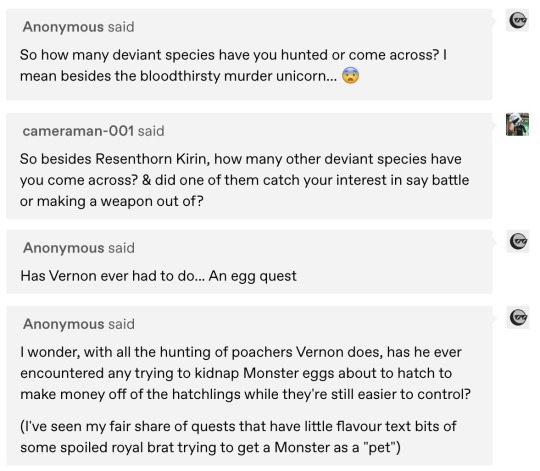
“Oh, I have a story that might sate y'all's curiosity. It includes poacher hunting, Wyvern eggs...
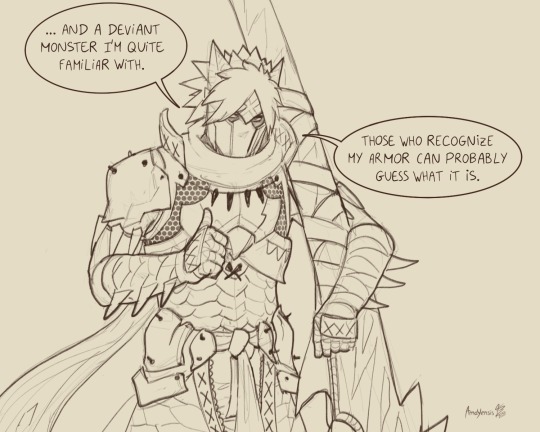
I remember very well the first time we met; I had joined the anti-poaching field barely a few weeks before, and was just assigned to a new mission, far away from usual hunting grounds. While most of our team took care of the poachers, my leader took me alone with him for a special task. I was still wearing my regular Nargacuga armor back then...
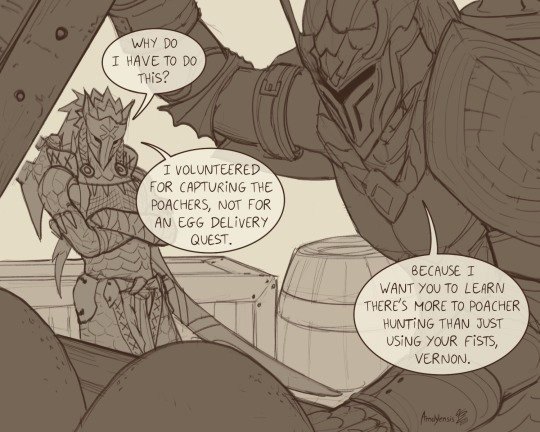

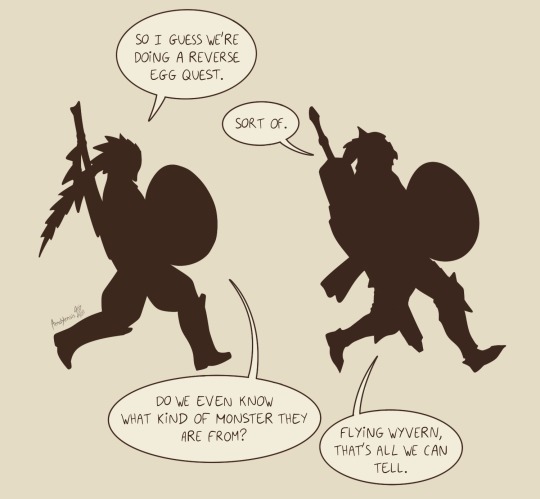
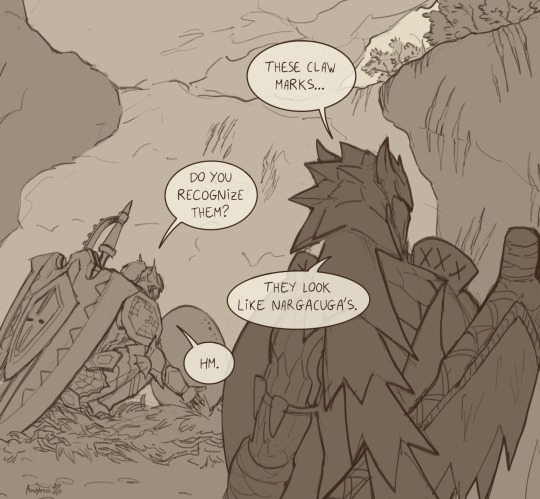



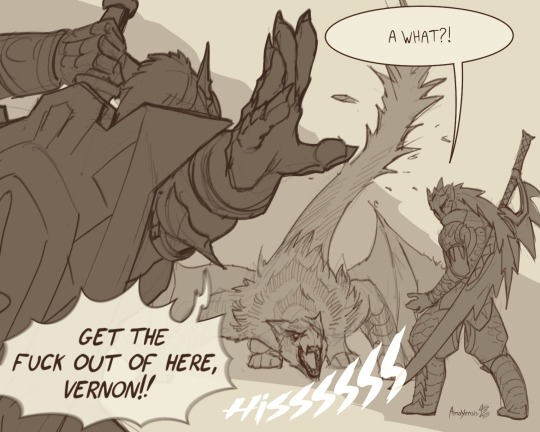

We ran to take cover, as we didn't want to harm the beast; but the terrain was irregular and hard to navigate.




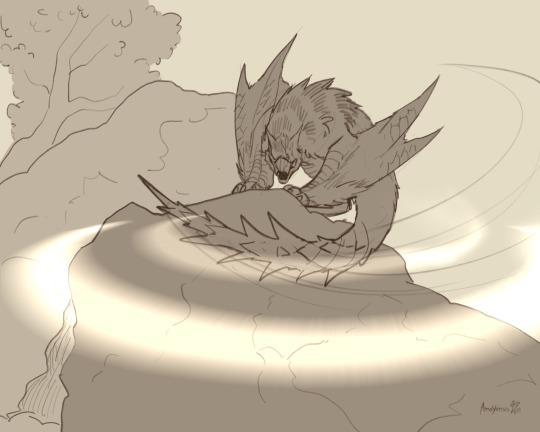
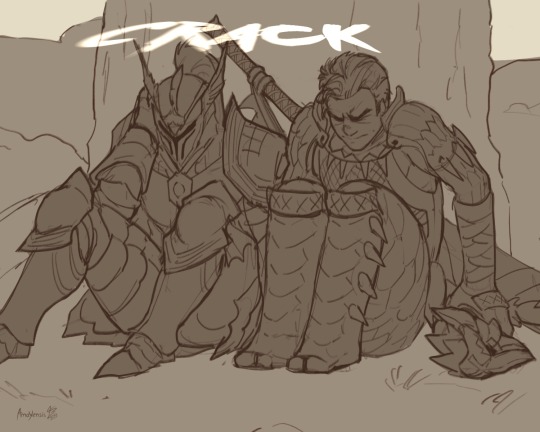
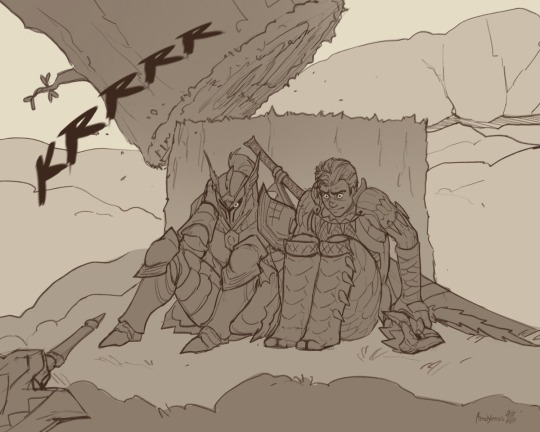
Luckily, she didn't want to leave her nest, as my superior suspected; letting us escape with no harm. Who knows how far she would have chased us otherwise... And she could have hurt me quite bad as my armor wasn't nearly strong enough to resist one of her blows.
But it seems the experience thrilled me more than it deterred me. As soon as I received my first Special permits, a few weeks later, I took every opportunity I got to hunt Silverwinds that wandered too close to towns. The beast challenged my skills and determination like very few had before, making me grow into a stronger hunter.
I have also met other types of deviants, some more rare than others, that I may talk about if you wish... But I have never seen that one-eyed female Silverwind again.”
#vernon#ask#poacher hunter#egg#kushala armor#nargacuga armor#nargacuga#silverwind#deviant#a more common deviant for now...#so many asks for the cost of one#and way too many doodles#there are 17 drawings in this single post#please let me know your thoughts on this type of stories!#since it takes effort to make#to know if it is worth it#it encourages me to go on#happy new year everyone!
132 notes
·
View notes
Text
Conservation of A Great Ape: The Orangutan
The orangutan, known for its distinctive red hair and human-like behavior, is one of the most endangered primate species in the world. Found only on the islands of Sumatra and Borneo, these intelligent and gentle creatures are threatened by habitat loss, poaching, and the illegal pet trade. Conservation efforts are essential to protect the remaining populations of orangutans and ensure the survival of these majestic creatures in the wild.
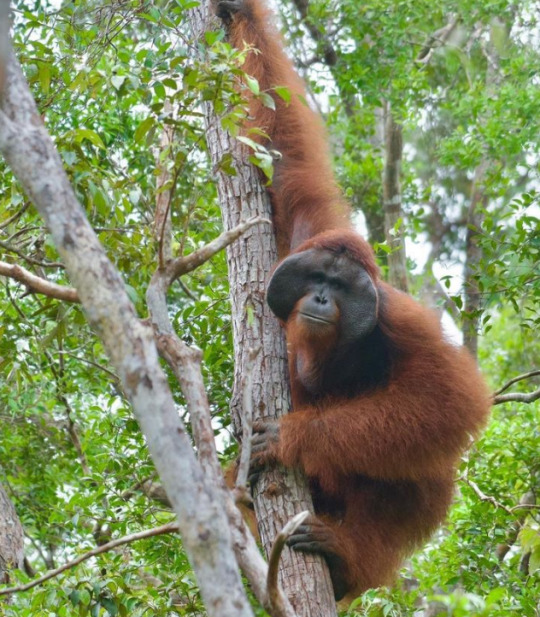
The Ecology of the Orangutan
Orangutans are the largest arboreal mammals, with adult males weighing up to 200 pounds and standing around 5 feet tall. Their long, powerful arms enable them to move through the trees with ease, and they use their four-foot-long arm span to reach branches that are too far away for their legs to reach. Orangutans have long fingers and toes with opposable thumbs, allowing them to grasp objects with great dexterity, making them proficient tool-users. Their hair is a distinct reddish-brown color that fades to gray as they age, with males developing distinctive cheek pads that grow throughout their adult lives.
Orangutans are also incredibly social animals, with complex communication skills and strong family bonds. Female orangutans maintain strong bonds with their offspring, raising them for up to eight years before they become independent. Adult males, on the other hand, are solitary and territorial, only interacting with females during breeding season. While orangutans are generally peaceful, males have been known to display aggressive behavior towards other males, especially during mating season.
Unfortunately, these intelligent creatures are under threat from a variety of human activities, including deforestation, poaching, and the illegal pet trade.
youtube
What threatens the Orangutan?
The primary threat to orangutan populations is habitat loss. Deforestation, driven by logging, agriculture, and palm oil plantations, is the most significant cause of habitat destruction in Borneo and Sumatra. In the past few decades, the orangutan’s habitat has been reduced by 80%, leaving the remaining populations confined to small, isolated pockets of forest. This fragmentation makes it difficult for orangutans to find food, mate, and establish social connections, which can lead to a decline in their population numbers.
In addition to habitat loss, orangutans are also threatened by poaching and the illegal pet trade. Orangutan babies are often captured and sold as pets, while adult orangutans are hunted for their meat or body parts, which are used in traditional medicine. Poaching and the illegal pet trade have contributed to a decline in the orangutan population, and it is estimated that only 80,000 orangutans remain in the wild today.
Conservation of the Orangutan
Conservation efforts are essential to protecting orangutan populations and ensuring their survival in the wild. One of the most critical steps in orangutan conservation is habitat protection. Protecting orangutan habitat means preserving the remaining forests where orangutans live, and creating corridors between fragmented forests to enable populations to intermingle and reproduce. It also means reducing the impact of human activities such as logging, agriculture, and palm oil plantations, which are driving deforestation in Borneo and Sumatra.
Another key conservation effort is anti-poaching and law enforcement. Strict laws and regulations must be enforced to prevent illegal hunting and the illegal pet trade. Wildlife rescue and rehabilitation centers are also essential for orangutan conservation, providing a safe haven for rescued orangutans that have been injured or orphaned. These centers help rehabilitate orangutans and prepare them for release back into the wild.
Community engagement is another crucial aspect of orangutan conservation. Local communities play a vital role in protecting orangutan habitat and reducing the impact of human activities on the forest. Engaging with these communities, educating them about orangutans, and empowering them to participate in conservation efforts can help build support for orangutan conservation and reduce the impact of human activities on the forest.
We at Think Wildlife Foundation recently launched our Livelihoods for Conservation project to provide alternative, sustainable livelihoods to the communities living with wildlife. This is with the aim to incentivize conservation while uplifting these communities economically. You can purchase merchandise from these communities here!
Written by: Sanghmitra Singh
Originally published at https://thinkwildlifefoundation.com on June 29, 2023.
13 notes
·
View notes
Text
my parents aren't exactly fundamentalist people, but the day to day of living in a culture with a strong eschatological belief was enough to be traumatizing, no matter what religion it is. and im sure this is not just me, most people are just too afraid to even acknowledge how it fucks with them.
take a typical nature phenomenon, like eclipses, stars, black holes, sandstorms, weird animals, or rivers gone red from algae. this thing should have inspired curiosity right? well, in my country, all of the news articles and science videos regarding the subject is filled with people proselytizing, warning others its a sign of the apocalypse. worse when its a disaster like floods or tsunami or heatwaves or even extinction from poaching and environmental destruction. i've had people saying brazenly that climate change isn't man-made but god's punishment because the apocalypse / rapture is coming soon and we have too many LGBT people existing so of course trying to stop it would be a waste of effort, so just pray and prepare for akhirah and abuse others into falling in line.
the media does not help either. they made cheap infographic shows that are literally just about scaring people about the end of the world. a baby born with a life-threatening disability gets turn into shock fodder for tv because its born with one eye on its forehead. thats evil. do they even think of the effect it will cause for disabled people? of course they dont, in their mind theyre doing good because theyre reminding people that the apocalypse is coming soon and they should repent. i wonder, if someone from 2012 see a one-eyed child, would that kid be safe?
and in terms of personal experience, its horrifying to hear adults say, "yeah dajjal (the anti christ) will show up in your lifetime so you'll see the end of the world" and think that your parents didn't care enough to even think of the implication of bringing you to this world when its so corrupt and rotten. especially when you grow up knowing something is wrong and different with you.
and its not just that. its the end of the world, of course people would constantly talk about it in hushed tones. i've seen predictions shared in facebook or whatsapp groups, talked by kids and adults in sermons and hearsays. it turns people hostile to others with a different religion, or at best, they learn to be apathetic or detach their inherent empathy to other people because they have a different religion so theyre going to hell for eternity. so why fucking bother being tolerant or befriending them? you dont want to commit a grave sin since you wished a non-muslim to go to heaven for their good deeds right?
and when i was a kid, my friends would all have this strategy to prepare for judgement day. creating a culture where kids make up survival scenarios to prevent eternal, senseless torture is bad. and hypocritical when you keep saying god's love and care are boundless and unconditional.
my dad and every preacher i know always say to not be afraid of death, its something to look forward to, because you'll meet god, but you cant kill yourself and you must make sure even if its a natural death you live in the right way so you dont go to hell and be tortured for eternity. i agree death shouldnt be feared, but none of these people are truly unafraid of death. they shaped their entire life to make sure their death is the right one, and they force others to have belief out of a misguided sense of love.
i had an uncle who went far into this religious group, and even if the practices are completely identical to mainstream sunni islam, the man stopped providing for his wife and just pray and pray without doing anything else. believing god would simply take care of everything and even if he didn't, the apocalypse is coming soon! becoming too successful will just distract you from akhirah anyway.
its disgusting. i dont care what any religious/spiritual people on this site says. religion never gave people a sense of gratefulness or wonder or fulfillment. it turn them into incurious, selfish, frightened fucks that are too helpless to even fight for themselves and their home because the world is ending and its an inevitability so why bother? but thats the best case scenario. at worst, the eschatological sentiment turn people raging bigots abusing others so they'd convert or fall in line with cisheteropatriarchy and blame every tragedy to powerless minorities instead of the people in power.
i might have some faith left in me, but i would still advocate for state atheism. because its obvious every dominant religion will be used as a tool for terror and submission.
#religion#religious trauma#ex muslim#apostasy#islamophobes and anti muslim bigots DNI#long post#posts about my life
9 notes
·
View notes
Note
I get people are sensitive with gore, but holy fuck is the point of the march event going over y’all’s heads. “I’m not gonna play during the month that my playing will give money to anti-poaching charities because i can’t stomach the fake images of what’s happening irl”
If you feel antagonized then do some self reflection bc nobody here is calling you a villain, just saying that you’re missing the point of an event about saving animals. you don’t wanna see a faceless elephant, an elephant doesn’t wanna be faceless.
Idk about ‘shock value’ anon because i wouldn’t call it that really. Anyways, this falls back into the 16+ rating of the game. Google says 16+ ratings mean the content may contain: strong violence and gore, sexual content, drug/substances and strong language.
.
2 notes
·
View notes
Text
■contribution: From an article by Kaushik Patoway for Amusing Planet-
Large herbivores such as elephants often seek out natural mineral deposits such as rocks and soil to supplement their dietary intake of sodium whenever the mineral is not obtained in adequate quantities from woody plants and natural water which elephants consume. So it is not uncommon to find elephants devouring soil and licking rocks high in sodium content. In Mount Elgon National Park on the Kenya-Uganda border, elephants have taken this activity a step further—they have learned to quarry sodium-rich rocks on the base of a 24-million-years-old extinct volcano called Mount Elgon.

Mount Elgon is believed to be the oldest extinct volcano in East Africa. Because of its unusually large form—an 80 kilometer wide base and a peak that rises 3,000 meters from the surrounding plains— Mount Elgon doesn’t have the typical sharp rise of a volcanic mountain. The rise is more gradual, and as the land rises the vegetation changes and so does the climate. The forest becomes thicker and air becomes chilled. Many rare plants and animals seek shelter in the higher slopes of Mount Elgon to escape the heat of the plains.
The elephants prefer to stay in the lower slopes where there are a number of caves and salt is plenty. These caves are quite voluminous, with up to 150 meters long, 60 meters wide, and some 10 meters high. There is evidence that these caves have been artificially expanded by thousands of years of mining—not by humans, but by the pachyderms.

The elephants use their tusks to break off pieces of the cave wall, which they then chew and swallow, leaving long scratch marks all over the cave walls. The elephants chisel the rocks for several hours and eat large quantities of salt at a time, since they usually do not return until several weeks later. The elephants have a voracious appetite for salt. One young bull elephant at the Aberdare National Park in Kenya was observed to consume 14 to 20 kg of salty soil in 45 minutes. From another observation of a young calf feeding himself rocks inside Kitum Cave in Mount Elgon, researchers estimate that on average an elephant excavate about two liters volume of rocks from the cave.

Illustration credit: Ian M. Redmond
Aside from elephants, other animals such as bushbuck and buffaloes are also drawn to the salt in the caves. It’s unlikely the animals know they need salt in their diet. The behavior is mostly instinctive, developed over thousands of years, and by leading their young into the caves, the knowledge has been passed on through the generations.
Some predators such as leopards and hyenas take advantage of this behavior by hiding in the darken interior of the caves and attack weaker animals such as elephant calves, buffaloes and bushbucks. The worst happened during the 1980s when poachers discovered this trick. They hid near the entrance to the caves and ambushed the elephants as they approached. From more than 1,200, the population of Mount Elgon's elephants fell to under one hundred. Poaching radically altered the behavior of the elephants—they became more secretive and started avoiding the better-known caves.

The fall in ivory prices in the 1990s and a more determined anti-poaching effort by the Kenyan government gave the elephants some respite. The situation has improved since the last two decades, but the future is anything but bright.

Tusk marks on the wall of the caves.
■thought: From the time I was a child and heard the phrase "an elephant never forgets" to seeing the videos in my early adulthood of the parade of mourning elephants gently stroking the bones of their long lost loved one, elephants have been an animal that I have a strong connection to and feel very strongly about. Knowing whole structures have been carved out of ancient rock by this specific parade brings me much joy. What other animal structures exist out there? What else are elephants capable of knowing and doing? What does this mean regarding the conservation efforts for these wizened, leathery giants? So much appreciation to the conservationalists studying these amazing members of our Earth family.
If you would like to know more about Mount Elgon National Park and Kitum Cave, their website can be found here.
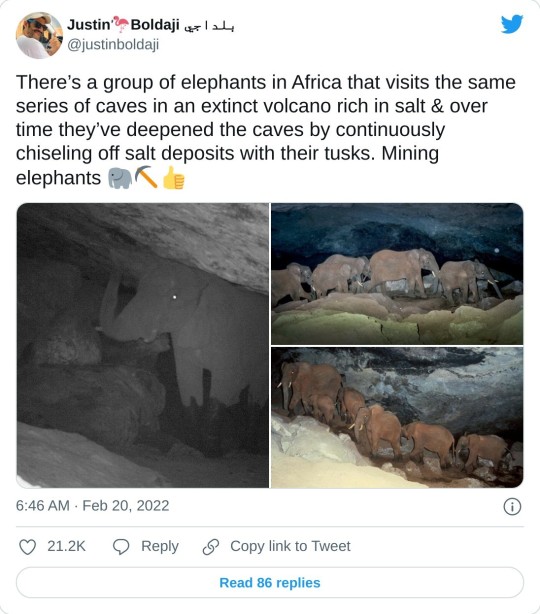
View on Twitter
These pictures are killing me


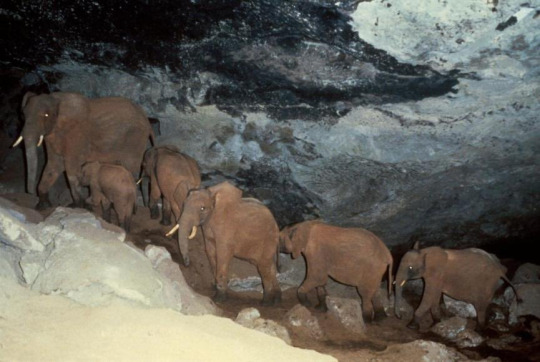
#tumblr post#twitter post#tumblr text post#animals#animal behavior#contribution post#Elephants#Africa#Kenya#Mount Elgon#Kitum Cave#east africa#animal conservation
181K notes
·
View notes
Text
Price: [price_with_discount] (as of [price_update_date] - Details) [ad_1] A Perfect Poacher you can adjust the time according to your own microwave. Cook two eggs in minutes, simply fill with water and add eggs to make a tasty breakfast, save time and effort.Specification :Egg SteamerMaterial : Food Grade PlasticSize : 22 x 10.5 x 6 cmColor : BlueFeatures :Double microwave egg poacher,high capacity design.Health,safety and convenient,save time,prepare breakfast quickly.Easy to clean, just rinse with water.High temperature resistant, safety.Package Include: 1 * Microwave Egg Cooker Health, safety and convenient, save time, prepare breakfast quickly. Thicken design, can withstand strong impact, anti-falling and pressure resistance, to poach eggs perfectly. High capacity design, health, safety and convenient, make perfect poached eggs, prepare breakfast in minutes. BPA free and dishwasher safe, easy to clean. Just rinse with water after poaching eggs. High temperature resistant, safety. Cook two eggs in minutes, simply fill with water and add eggs to make a tasty breakfast, save time and effort. [ad_2]
0 notes
Text
10 Fun Facts About Mountain Gorillas

Did you know that Rwanda is home to over a third of the world’s mountain gorillas? With only around 1,000 of these incredible animals left in the wild, Rwanda’s Volcanoes National Park has become a haven for them—and an absolute dream for wildlife lovers. These gentle giants are not only fascinating creatures but also a symbol of what dedicated conservation can achieve.
If you’re curious about these majestic animals and planning a visit to see them, here are 10 fun facts that will get you even more excited!
1. Gorilla Family Dynamics
Mountain gorillas live in tight-knit family groups, usually led by a big, dominant male known as a silverback. Think of him as the ultimate protector of the group. These silverbacks can weigh up to 430 pounds (195 kg), and they’re in charge of keeping everyone safe, finding food, and resolving any gorilla “family drama.”
The females play an equally important role, looking after the little ones and making sure the group stays close. And speaking of little ones, the youngsters are super playful—they’re always running around, climbing trees, and goofing off, just like human kids!
2. Unique Physical Characteristics
Mountain gorillas are physically impressive in every way. One unique thing about them? Their nose prints are just like human fingerprints—no two are alike. This is how researchers identify each individual gorilla!
These animals are also ridiculously strong. Adult males can lift more than 1,800 pounds (800 kg)! And believe it or not, they have opposable thumbs just like us, which helps them grab food and even use tools. Their thick fur keeps them warm in Volcanoes National Park’s chilly, high-altitude environment, where it can get pretty cold at night.
3. Diet and Foraging Habits
Mountain gorillas are strict vegetarians, which means they feast on a ton of different plants, including bamboo shoots and wild celery. In fact, an adult gorilla can chow down on up to 40 pounds (18 kg) of vegetation in a single day!
They spend most of their day eating and foraging for food, which means they’re always on the move, covering about a mile a day. Their diet changes depending on the season, which keeps things interesting as they’re always seeking out the freshest plants!
4. Intelligent Behaviors
These gorillas aren’t just strong—they’re also incredibly smart. They’ve been known to use tools, like sticks, to gauge the depth of water or to help with gathering food. This problem-solving ability shows just how intelligent they really are.
What’s even more amazing is their emotional intelligence. Gorillas have deep emotional bonds with each other, and they express a wide range of emotions, from joy and playfulness to grief and sadness. If a member of the group gets hurt or passes away, the entire family shows signs of distress, proving how emotionally connected they are.
5. Conservation Efforts in Volcanoes National Park
Mountain gorillas were once on the brink of extinction, but thanks to ongoing conservation efforts, their population is slowly growing. In the 1980s, there were only about 250 gorillas left in Rwanda, but now that number has risen to over 600.
This success is largely due to the efforts in Volcanoes National Park, which includes anti-poaching patrols, habitat protection, and involving the local community in conservation. Many locals now benefit from tourism, which means they have a vested interest in keeping the gorillas safe and thriving.
6. Gorilla Tracking Experiences
If you’re thinking about trekking to see these gentle giants up close, you’re in for a treat! But because gorillas are endangered, Rwanda limits the number of people who can visit them each day through a permit system. This helps protect the gorillas while still allowing visitors to experience them in the wild.
Gorilla trekking can be a bit of a challenge, though. You’ll need to hike through dense forests, and the trek can take anywhere from 1 to 4 hours depending on where the gorilla families are. But trust me, when you finally see them, all that effort will feel worth it! For the best experience, visit during the dry seasons, between June and September or December to February, when the trails are easier to navigate.
7. Communication Methods
Gorillas have a complex way of communicating that goes beyond just sounds. They use a variety of vocalizations, including grunts, roars, and even purrs, to talk to each other. These sounds help them express everything from happiness to warning signals.
In addition to vocal communication, they use a lot of body language and facial expressions. A pounding chest is the classic sign of a dominant male, while more subtle gestures like grooming show affection. Their communication is key to maintaining harmony within the group.
8. Gorilla-Human Similarities
One of the coolest things about mountain gorillas is how similar they are to us. Did you know they share 98% of their DNA with humans? No wonder we see so much of ourselves in their behavior!
They live in family units, mourn their dead, and have strong social bonds, just like humans. They also show a wide range of emotions, from happiness and curiosity to anger and sadness, making them even more relatable.
9. Habitat and Range in Volcanoes National Park
Mountain gorillas live in the high-altitude rainforests of East Africa, and Rwanda’s Volcanoes National Park is one of the last places on Earth where they can be seen in the wild. They prefer altitudes ranging from 7,200 to 14,100 feet (2,200 to 4,300 meters) and build nests from vegetation every night to sleep in.
Their home range can be as large as 16 square miles (41 square kilometers), but it varies depending on how much food is available. Since they’re always looking for fresh plants to eat, they’re constantly on the move.
10. Gorilla Lifespan and Growth
Gorillas go through different stages of life, just like humans. When they’re born, they weigh only about 4.5 pounds (2 kg), and they stay super close to their mothers for the first few years. As they grow, they start exploring more and interacting with other group members.
By the time they hit adolescence (around 8-12 years old), they’re pretty independent but still very much part of the group. In the wild, gorillas can live up to 35 years, though some have lived even longer in captivity.
ConclusionMountain gorillas are truly one of nature’s wonders, and Rwanda’s Volcanoes National Park offers a rare chance to see them in their natural habitat. From their complex social lives to their emotional intelligence and impressive physical traits, these gentle giants continue to amaze visitors from around the world.
If you’ve been dreaming of experiencing gorilla trekking for yourself, now is the perfect time to make it happen! Ready for the adventure of a lifetime? Check out our itineraries and book your trip today! 🌍🦍
1 note
·
View note
Text
HR Services for Financial Firms: Building a Strong Workforce for a Dynamic Industry
HR services are crucial today in a fast-paced and competitive financial sector for sustaining a talented, engaged, and compliant workforce. Highly regulated and complex environments play host to the financial firms, presenting them with distinctive challenges over talent acquisition, employee retention, compliance, and organizational culture.
These services will assist financial companies in countering some of these challenges by optimizing workforce management, ensuring compliance with the industry regulation, and fostering a high-performance culture. This blog focuses attention to very important HR services that financial institutions need to succeed in the marketplace and stay competitive while remaining ahead of their games.
Salahkaar Consultants offers these services in many global markets. Visit their website at http://www.salahkaarconsultants.com and contact them to see if they can help your company as well.
1. Talent Acquisition and Recruitment
The financial industry is quite demanding in terms of professional competencies, ranging from financial analysts to risk managers, investment bankers, and compliance experts. The field is highly competitive since the standard of competition continually raises the bar.
HR Services Solution:
Specialized Recruitment: Financial companies will highly benefit from an HR service specializing in recruitment of finance professionals. Such HR providers are most likely to have deeper knowledge about the industry and will, therefore, source candidates holding skills and various certifications, for instance, Chartered Financial Analyst (CFA), Certified Public Accountant (CPA), or Financial Risk Manager (FRM).
Employer Branding: Building an employer brand becomes essential in such a competitive marketplace. HR services would help financial organizations build and market a strong employer brand to attract and retain top talent through various career growth opportunities, company culture, and benefits to potential employees.
RPO: The recruitment process will most likely be outsourced to save time and resources for large financial institutions. All steps, ranging from candidate sourcing up to interviewing and onboarding, can be maintained by HR services to ensure seamlessness while leaving firms focused on core business functions.
2. Employee Training and Development
The financial industry has to innovate constantly in the light of new regulations, technologies, and market trends that enter the scene regularly. Hence, financial firms must continually invest in the ongoing training and development of employees to stay competitively ahead in the constant flux.
Regulatory Compliance Training. The same can be prepared and offered by HR service providers, such as financial regulations, which include anti-money laundering (AML), Know Your Customer (KYC), and General Data Protection Regulation (GDPR). A large industry is the financial industry, where the fine for non-compliance is heavy and there is also brand reputation damage.
Leadership Development Programs: HR services can develop leadership development programs which can instill the future talent for leading financial firms. It is more of the building strategy, decision making, and team management skills of the leaders.
Technology and Fintech Training: Fintech will disrupt sectors, so professional training for new technologies such as blockchain, AI, and data analytics will be offered by HR services, which will keep the employees up-to-date with the changes in the financial service landscape.
3. Performance Management and Retention
Financial services firms are especially concerned about retaining the best talent because top performers tend to get poached by competitors. On the other hand, effective performance management and retention strategies have a direct role in ensuring that employees remain motivated, engaged, and committed to the company.
HR Services Solution:
Performance Appraisal System and Human Resource Services: Systematic performance appraisal systems under HR services will provide regular feedback to the employee. Such systems help identify areas for improvement, establish goals, and recognize high-performing employees who contribute to enhanced productivity and satisfaction.
Incentive and Rewards programs: Nowadays, it is a trend that financial firms have developed incentive-based compensation models or bonuses and commissions. Possible under HR services is designing an incentive program for firms that is in line with the realization of the firm's goal for compensating fairly with regard to contributions.
Employee Engagement Surveys: Human resource services for some organizations will conduct employee engagement surveys to help understand how happy the employees are within the organization. The outcome of such surveys reveals the areas with probable concerns and strategies for a better culture in the working environment. Engaged employees are most likely to stay with the company and perform at a high level.
4. Compliance and Risk Management
The most important thing for financial institutions, in this respect, is to be compliant to the regulatory requirements. HR plays an important role for assurance that every employee is in compliance with them, and the firm is being protected from all risks of non-compliance, frauds, and unethical practices.
Salahkaar Consultants offers these services in many global markets. Visit their website at http://www.salahkaarconsultants.com and contact them to see if they can help your company as well.
HR Services Solution:
Conduct Compliance Audits: HR services might perform regular compliance audits to ensure that policies and procedures of the firm comply with appropriate and updated industry standards and regulations. This will include reviewing employee classifications and wage practices as well as reviewing the workplace safety protocols.
Risk Management Training: Risks facing financial firms relate to operational, reputational, and legal risks. HR services might deliver risk management training to the employees, and the priority is knowing potential risks and mitigating responses.
Whistleblower Policies: Human Resource services would help financial institutions develop and implement whistleblower policies that enable employees to report unethical practices or any breach of compliance without fear of retaliation, keeping the workplace open and honest.
5. Diversity and Inclusion Initiatives
Diversity and inclusion in the financial industry is emerging as an essential issue, as firms realize that there is value in having a diverse workforce. In many ways, indeed, a more diversified workforce will bring diverse perspectives, promote innovation, and potentially enhance the decision-making process.
HR Services Solution:
Diversity Recruitment Strategies: The HR services ought to be able to assist the financial firms in developing the different recruitment strategies that were primarily aimed at attracting candidates from diverse backgrounds. Such would include offering partnership with minority organizations, conducting job fairs targeted at diversity and promotion of inclusive hiring practices.
Inclusion Training Programs: HR services will offer training programmes that educate workers on unconscious bias, cultural sensitivity, and inclusive leadership. Training programs help to create a culture at work by being less biased, thereby giving every employee a sense of belonging.
Mentorship and Sponsorship Programs: The human resource services can design mentorship programs in which junior employees are paired with higher-level leaders. These services can target the mentoring efforts toward underrepresented groups. The creating of an inclusive environment within financial firms may further be enhanced through active sponsorship programs where higher-level leaders take an active interest in using their power to advance the careers of diverse employees.
6. Compensation and Benefits Management
Any company that competes in the financial services sector for top talent should provide competitive compensation and benefit packages. Financial firms must create packages that are not only competitively compensating but also competitive with respect to industry benchmarked standards and employee expectations.
HR Services Solution:
Thus, compensation benchmarking studies will help HR services ensure that financial firms provide industry competitive salaries and benefits. This will attract top talent to the firm and reduce the risk of losing employees to other firms.
Benefits Administration: HR services can administer benefits programs, including health insurance, retirement plans, and wellness initiatives. Outsourcing of benefits administration to HR services ensures regulatory compliance with rules and regulations and alleviates administrative burdens of the firm.
Executive Compensation Consulting: Financial firms will have often relatively quite complicated structures in the compensation of their senior executives. HR services will be able to provide consulting on executive compensation, including bonuses, stock options, and long-term incentive plans. They will ensure that these are compatible with the overall strategy and governance of the firm.
7. HR Technology Solutions
Technology is changing HR practices across industries, including financial services, by streamlining processes, enhancing improved decision-making, and generally improving the employee experience.
HR Services Solution:
HR Information Systems: HR services will implement HRIS applications that hold all the employee's data in a central location, automate payroll processing, and expedite performance management. This will call for less administrative work and increase the accuracy level.
Self-Service Portal: Through self-service portals, employees will automatically gain access to all HR-related activities without contacting the department. As such, updating personal details, uploading pay slips, and requesting days off will require minimal involvement of the people in the HR department.
Data Analytics for Workforce Planning: HR services can use data analytics to help determine workforce trends, employee performance, and retention rate data. Financial firms can then be informed in their decision making about workforce planning and strategy through the use of such data.
Conclusion
HR services play an important role in a financial firm's success when providing customized solutions for recruitment, compliance, performance management, and engagement of employees. Financial firms, through correct implementation of HR strategies, can create a strong and dynamic workforce, which is better geared to overcome the challenges in the rapidly changing industry. They may then have greater time and attention to invest in their core business objectives while making sure that at both ends, employees face the problem and are motivated enough to make the company succeed.
Salahkaar Consultants offers these services in many global markets. Visit their website at http://www.salahkaarconsultants.com and contact them to see if they can help your company as well.
0 notes
Text
Conservation Efforts in Thekkady: How the Forests are Protected

Thekkady is one of Kerala's most valued natural reserves, renowned for its rich fauna and lush forests. The Periyar Wildlife Sanctuary, a sanctuary for animals and an essential environment for many species of plants and animals is located in the center of this area. The community and authorities of Thekkady actively participate in conservation efforts to protect this priceless natural scenery, which adds to the area's uniqueness beyond merely its natural beauty.
A Rich Ecosystem Under Protection
With 925 square kilometers under its protection, the Periyar Wildlife Sanctuary is a hub for wildlife. The sanctuary, which is home to tigers, sambar deer, elephants, and many bird species, is essential to the preservation of India's wildlife. In addition to acting as a habitat, these woods are vital wildlife corridors in the Western Ghats. These woods are very important, so it is imperative that measures to preserve and safeguard them are well thought out and carried out.
Engaging Local Communities
The local population's strong participation in conservation initiatives is one of Thekkady's most notable features. Poaching and illicit logging were major dangers to the health of the forest in the past. But thanks to programs like the Eco-Development Committees (EDCs), the people who before depended on these harmful activities have been transformed into forest guardians. By providing alternate revenue streams like eco-tourism, these committees lessen the impact of human activity on the forest.
These initiatives enable locals to support conservation efforts while earning a living wage. Examples of this employment include eco-guides for trekking and safaris. This win-win concept demonstrates how environmental conservation and sustainable growth may go hand in hand.
Anti-poaching and Wildlife Protection
The Periyar Tiger Reserve, a vital portion of Thekkady, features one of the most thorough anti-poaching initiatives in India. The refuge turns ex-poachers into forest guards in an effort to stop illicit hunting, converting them from threats to wildlife defenders. These men now assist in ensuring that poaching is kept under control and that animal populations are watched after and safeguarded thanks to their extensive knowledge of the forest and the behavior of wildlife.
In order to make sure that the wildlife, particularly endangered animals like the Bengal tiger, is well-protected, the forest service uses sophisticated monitoring tools, video traps, and routine patrols to track movements and activities within the reserve.
Forest Fire Prevention and Management
Forest fires can cause irreparable damage to ecosystems, and Thekkady’s forests are no exception. To tackle this threat, the Periyar Tiger Reserve employs strict fire management protocols. Firebreaks, cleared paths in the forest, are created to stop the spread of fires, and watchtowers are used to keep an eye on potential fire hazards. In addition, local tribes and community members are trained to help control and manage fires, ensuring quick responses and minimizing damage.
Responsible Tourism and Sustainability
Thekkady depends heavily on tourism, but as more people visit, there is a chance that the ecosystem that draws them in will be harmed. Strict laws that encourage responsible travel have been put in place to counteract this. Visitors are warned not to litter, are informed about the value of conservation, and are discouraged from upsetting the wildlife.
The Periyar Green Walk program, which enables visitors to explore the forest sustainably, is one noteworthy endeavor. Visitors are taken on nature hikes by knowledgeable tribal guides who urge them to enjoy the ecology without causing any disturbances. This program promotes a deeper appreciation and reverence for the environment.
Many hotels in Thekkady also contribute to conservation efforts by adhering to eco-friendly practices. These include the use of solar power, rainwater harvesting, and waste management systems to reduce their environmental footprint. Travelers are encouraged to stay at eco-conscious accommodations, further promoting sustainability in the region.
Biodiversity Conservation Projects
Thekkady is home to numerous ongoing conservation and research initiatives aimed at maintaining the ecosystem's equilibrium. These initiatives concentrate on understanding the effects of human activities, investigating animal behavior, and developing innovative approaches to environmental protection.
An important part of conservation efforts is reforestation, where thousands of trees are planted year to preserve the integrity of the forest and recover degraded regions. These programs aid in lowering soil erosion, enhancing water retention, and giving wildlife refuge and food.
In summary
The local people, forest officials, and visitors to the area have all contributed to the conservation efforts in Thekkady, which is a witness to their commitment and collaboration. Thekkady is still a wonderful destination for nature enthusiasts and a sanctuary for wildlife because of the preservation of this fragile ecosystem. Responsible tourism, community involvement, and anti-poaching patrols work together to guarantee that Thekkady's forests are preserved for the enjoyment and experience of future generations.
0 notes
Text
The Impact of Drone Technology on Various Industries

Unlocking New Career Paths:
The rapid advancement of drone technology has opened up numerous career opportunities across a wide range of industries. From agriculture to media, the applications of drones are vast and varied, creating a demand for skilled drone operators. SPH Aviation, a leading drone training institute in India, is at the forefront of this revolution, offering comprehensive courses that equip students with the skills needed to excel in this dynamic field. Here’s how drone technology is transforming various industries and why training at SPH Aviation is your gateway to a successful career.
Revolutionizing Agriculture with Precision Farming
Drones are revolutionizing agriculture by enabling precision farming techniques. They provide farmers with detailed aerial views of their fields, helping them monitor crop health, assess irrigation needs, and detect pests and diseases early. This technology allows for targeted interventions, reducing waste and increasing crop yields. SPH Aviation offers specialized training in agricultural drone operations, preparing students to contribute to the future of sustainable farming.
Enhancing Real Estate and Construction
In the real estate and construction industries, drones are becoming indispensable tools. They provide high-resolution aerial images and videos, offering potential buyers a unique perspective of properties. In construction, drones are used for site surveys, progress monitoring, and safety inspections. By enrolling in SPH Aviation’s drone training courses, you can learn to operate drones effectively in these sectors, making yourself a valuable asset to employers.
Transforming Media and Entertainment
Drones have significantly impacted the media and entertainment industry, enabling breathtaking aerial photography and videography. They are used in filmmaking, advertising, sports coverage, and even live events. With the right training, you can harness the power of drone technology to capture stunning visuals and tell compelling stories. SPH Aviation’s courses cover the technical and creative aspects of drone operations, helping you build a strong portfolio in media production.
Advancing Environmental Conservation
Drones play a crucial role in environmental conservation efforts. They are used for wildlife monitoring, habitat mapping, and anti-poaching operations. Drones provide a non-intrusive way to study and protect endangered species, helping conservationists gather vital data. SPH Aviation’s training programs include courses on using drones for environmental purposes, equipping you with the skills to contribute to meaningful conservation projects.
Innovating Surveying and Mapping
In surveying and mapping, drones offer unprecedented accuracy and efficiency. They can cover large areas quickly, providing detailed 3D maps and models that are crucial for urban planning, infrastructure development, and disaster management. SPH Aviation’s Survey & Mapping with RPC course teaches you how to use drones for these applications, making you proficient in this high-demand skill.
Enhancing Public Safety and Emergency Response
Drones are increasingly used in public safety and emergency response. They assist in search and rescue operations, disaster response, and surveillance. Equipped with thermal imaging cameras, drones can locate missing persons, assess damage, and provide real-time information to first responders. By training at SPH Aviation, you can learn to operate drones in high-stakes situations, contributing to public safety and emergency management.
Streamlining Logistics and Delivery
The logistics and delivery industry is exploring the use of drones for efficient and cost-effective solutions. Drones can deliver packages to remote areas, reducing delivery times and improving supply chain management. SPH Aviation’s comprehensive training programs prepare you to be part of this innovative sector, where drone technology is poised to make significant impacts.
Promoting Innovation in Engineering and Manufacturing
Drones are used in engineering and manufacturing for tasks such as inspection, monitoring, and quality control. They provide a unique perspective on production lines and infrastructure, helping identify issues and improve processes. SPH Aviation’s courses cover the technical aspects of drone operations in engineering, preparing you for a career in this innovative field.
Why Choose SPH Aviation?
SPH Aviation stands out as a premier drone training institute in India for several reasons:
Expert Instructors: Learn from industry professionals with extensive experience.
Comprehensive Courses: A wide range of programs tailored to various industries.
State-of-the-Art Facilities: Train with the latest drone technology and equipment.
Government Recognition: DGCA certified courses add significant value to your qualifications.
Career Support: 100% job assistance to help you secure the best opportunities in the industry.
Join SPH Aviation and take the first step towards an exciting and rewarding career in drone technology. Visit SPH Aviation to learn more about their courses and enroll today.
Contact: +91 85277 87146, +91 18001237199
Website: SPH Aviation
Instagram: Sph Aviation (@sphaviation) • Instagram photos and videos
Facebook: https://www.facebook.com/profile.php?id=61550342603590&mibextid=ZbWKwL
LinkedIn: https://www.linkedin.com/company/sph-aviation?trk=blended-typeahead
#drone training#rpto#drone#drone photography#industrial#new technology#drone pilot#uav#new career#dronelife
0 notes
Text
Botswana Safaris: An Unforgettable African Adventure
Botswana, a land of breath-taking landscapes and abundant wildlife, offers some of the most extraordinary safari experiences in Africa. With vast expanses of pristine wilderness, luxury lodges, and a commitment to sustainable tourism, Botswana is a top destination for those seeking an authentic and immersive safari adventure.

The Best of Botswana Safaris
Botswana’s safaris are renowned for their exclusivity and intimacy, providing travellers with a rare opportunity to experience Africa’s wildlife in its most natural and untouched state. Here are some of the highlights of a Botswana safari:
Okavango Delta: A Water Wonderland
The Okavango Delta, a UNESCO World Heritage Site, is one of the most unique safari destinations in the world. This vast inland delta is a labyrinth of waterways, lagoons, and islands, teeming with wildlife. Safari-goers can explore the delta by traditional mokoro (dugout canoe), gliding silently through the water as they spot elephants, hippos, crocodiles, and an array of bird species. The delta’s seasonal flooding creates an ever-changing landscape, making every visit a new adventure.
Chobe National Park: The Elephant Capital
Chobe National Park is home to one of the largest concentrations of elephants in Africa. The Chobe River, which runs through the park, attracts a myriad of animals, especially during the dry season when water is scarce elsewhere. A boat safari along the Chobe River offers a front-row seat to the incredible spectacle of elephants swimming and playing in the water, alongside buffalo, hippos, and crocodiles.
Moremi Game Reserve: The Heart of the Delta
Moremi Game Reserve, located in the eastern part of the Okavango Delta, is a haven for wildlife enthusiasts. The reserve’s diverse ecosystems, including floodplains, woodlands, and lagoons, support a wide range of animals, from lions and leopards to wild dogs and cheetahs. Moremi is also a birdwatcher’s paradise, with over 400 species recorded in the area. Game drives and walking safaris in Moremi provide close-up encounters with the rich wildlife of Botswana.
Central Kalahari Game Reserve: A Desert Experience
For those seeking a more remote and rugged safari experience, the Central Kalahari Game Reserve is the perfect destination. This vast expanse of semi-arid desert is home to unique wildlife, including the Kalahari lion, meerkats, and the elusive brown hyena. The reserve’s stark beauty and solitude offer a different perspective on the African safari, with endless horizons and dramatic sunsets.

Luxury Lodges and Camps
Botswana is known for its exclusive and luxurious safari lodges and camps, many of which are situated in private concessions. These lodges offer unparalleled comfort and personalized service, with spacious tents or suites, gourmet dining, and private guides. Many lodges are eco-friendly, blending seamlessly into the environment and supporting conservation efforts.
Sustainable Tourism and Conservation
Botswana’s commitment to sustainable tourism is evident in its low-impact, high-value approach to safaris. By limiting the number of visitors and focusing on quality experiences, Botswana ensures that its wilderness areas remain pristine and that wildlife thrives. The country’s strong conservation policies, including the protection of large tracts of land and anti-poaching measures, have made it a model for responsible tourism in Africa.

Plan Your Botswana Safari’s
Whether you’re a seasoned safari-goer or embarking on your first African adventure, Botswana offers an unforgettable experience. From the waterways of the Okavango Delta to the vast deserts of the Kalahari, a Botswana safari is a journey into the wild heart of Africa.
Prepare for an adventure of a lifetime—where the call of the wild meets unparalleled luxury and conservation. Botswana awaits.
0 notes
Photo

How Many Legs Does a Rhinoceros Have Rhinoceros are magnificent creatures that roam the plains and savannas of Africa and Asia. They are known for their impressive size, powerful horns, and thick skin. But have you ever wondered how many legs a rhinoceros has? In this article, we will explore the anatomy of these majestic animals and uncover the mystery of their legs. Rhinoceros Legs: The Basics A rhinoceros is a quadrupedal mammal, meaning it walks on four legs. Each leg is equipped with a sturdy hoof that helps the rhinoceros navigate rough terrain and support its massive weight. Rhinoceros legs are incredibly strong and can carry the animal's body, which can weigh up to several thousand pounds. The front legs of a rhinoceros are shorter and more stocky than the hind legs, providing stability and balance as the animal moves. The hind legs are longer and more muscular, giving the rhinoceros the power it needs to run at speeds of up to 30 miles per hour when threatened. Rhinoceros legs are also equipped with thick, tough skin that provides protection from thorns, rocks, and other hazards in their environment. This adaptation allows rhinoceros to traverse harsh landscapes without sustaining injuries to their lower limbs. Rhinoceros Legs: Adaptations for Survival In addition to their physical strength, rhinoceros legs have evolved to help the animals survive in their natural habitats. Rhinoceros have three toes on each foot, which spread out when they walk to provide better traction on uneven surfaces. This adaptation helps rhinoceros maintain their balance while running or climbing steep slopes. Rhinoceros legs are also vital for their defense against predators. A rhinoceros can kick with tremendous force using its hind legs, which are equipped with powerful muscles and tendons. This kick can easily injure or kill a predator that threatens the rhinoceros, making them formidable opponents in the wild. Company D: Your Source for Rhinoceros Conservation At Company D, we are dedicated to preserving and protecting rhinoceros populations around the world. Through our conservation efforts, we work to prevent poaching, habitat destruction, and other threats to rhinoceros survival. By raising awareness and funding for rhinoceros conservation projects, we hope to ensure that these magnificent animals continue to thrive in the wild for generations to come. One of the biggest threats facing rhinoceros today is the illegal trade in their horns, which are highly prized for their supposed medicinal properties in some cultures. By educating the public about the importance of rhinoceros conservation and supporting anti-poaching efforts, we aim to reduce the demand for rhino horn and protect these endangered animals from harm. How You Can Help Save Rhinoceros Legs There are many ways you can get involved in rhinoceros conservation and help protect these incredible animals. You can support organizations like Company D that are working tirelessly to save rhinoceros populations from extinction. By donating funds, volunteering your time, or spreading the word about the importance of rhino conservation, you can make a real difference in the fight to save these iconic creatures. You can also support sustainable tourism initiatives that promote responsible wildlife viewing and support local communities that live alongside rhinoceros habitats. By participating in eco-friendly tours and safaris, you can help ensure that rhinoceros continue to thrive in their natural environments without causing harm to their populations. In conclusion, rhinoceros legs are an essential part of these magnificent animals' anatomy and play a crucial role in their survival in the wild. By understanding the unique adaptations of rhinoceros legs and supporting conservation efforts, we can all do our part to ensure that these incredible creatures continue to roam our planet for generations to come. Remember, every step you take to protect rhinos counts – together, we can make a difference and save rhinoceros legs for future generations to admire and cherish. So let's join hands and work together towards a brighter future for these amazing creatures.
Rhinoceros Legs
0 notes
Text
Discover Uganda: Majestic Gorilla Trekking Adventures
Embark on a once-in-a-lifetime adventure with Interior Safaris East Africa as you explore the lush wilderness of Uganda through Gorilla Trekking Uganda. This unforgettable experience takes you deep into the heart of Africa's natural beauty, where you'll encounter the majestic mountain gorilla in its natural habitat. Discover why Uganda is the ultimate destination for this extraordinary journey, and prepare for an adventure that will inspire and amaze you.
Why Choose Uganda for Gorilla Trekking?
Uganda offers a unique opportunity to witness the magnificent mountain gorillas up close. The country is home to over half of the world's remaining mountain gorilla population, making it one of the best places for Gorilla Trekking Uganda. Uganda's Bwindi Impenetrable Forest and Mgahinga Gorilla National Park provide lush, pristine habitats for these gentle giants, offering visitors the chance to observe them in their natural environment.
The diverse biodiversity of Uganda enhances the gorilla trekking experience. Along with gorillas, you may encounter other wildlife species, including birds, monkeys, and forest elephants, as you trek through the dense vegetation.
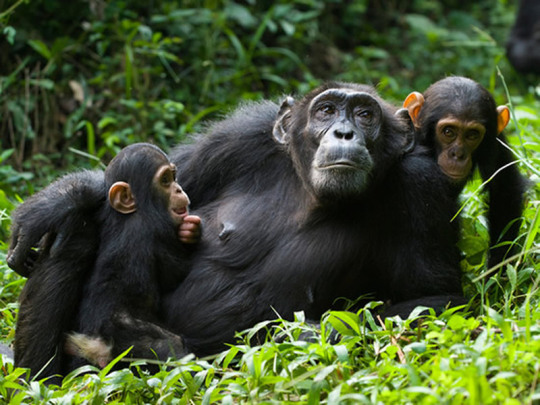
What to Expect During Gorilla Trekking?
Before setting out on your trek, proper preparation is essential. Trekkers should ensure they are physically fit for the hike, which may involve traversing steep and uneven terrain. Dressing appropriately with long-sleeved shirts, pants, and sturdy hiking boots is recommended.
Essential equipment includes waterproof clothing, a hat, sunscreen, insect repellent, and a backpack for carrying snacks and water. Additionally, a camera with spare batteries and memory cards will allow you to capture every memorable moment.
Safety measures are in place to ensure a secure and enjoyable experience. Experienced guides from Interior Safaris East Africa lead the treks, providing information and ensuring visitors follow strict rules to protect the gorillas and their habitats.
The Thrill of Encounter:
As you embark on your trek, you can expect a range of emotions as you approach the gorilla families. The experience of observing these majestic creatures in their natural surroundings is awe-inspiring and humbling.
Trekkers may witness the gorillas' daily activities, such as feeding, grooming, and playing. While maintaining a safe distance, visitors can observe the intricate social dynamics within the group and the strong bonds between family members.

Conservation and Sustainability:
Gorilla trekking contributes significantly to conservation efforts in Uganda. The revenue generated from trekking permits supports the protection of gorilla habitats and funding for anti-poaching patrols.
Interior Safaris East Africa prioritizes sustainable tourism practices, ensuring minimal impact on the environment and local communities. By participating in a gorilla trek, travelers help preserve the future of these incredible animals and their ecosystems.
Conclusion:
Gorilla Trekking Uganda with Interior Safaris East Africa offers an extraordinary journey into the heart of Africa's wilderness. Every step brings you closer to the magnificent mountain gorillas and the untamed beauty of their habitat. With its commitment to conservation and responsible tourism, Uganda stands as a beacon for unforgettable wildlife experiences.
Are you ready to embark on the adventure of a lifetime? Join us in Uganda for an incredible Gorilla Trekking Uganda expedition and discover the magic of encountering mountain gorillas in their natural habitat. Book your adventure today with Interior Safaris East Africa and let the journey begin!
0 notes
Text
How Hunting Supports Wildlife Conservation Efforts

Wildlife conservation is geared towards preserving the delicate balance of ecosystems and protecting endangered species. Hunting is a surprisingly crucial ally to wildlife conservation. The concept of hunting may appear as a threat to conservation. However, responsible and well-managed hunting contributes to ecosystem health, species preservation, and sustainable resource management.
The connection between hunting and conservation is traced back to the late 19th century in the United States. During that time, hunting was done as a source of income, where merchants sold animal meat and fur for a good price. Unfortunately, some hunters abused the hunting grounds, almost driving some animal species to extinction. Luckily, professional hunters and other citizens who saw this as a threat to wildlife teamed up to advocate for hunting regulations.
Today, several laws have been passed by Congress to ensure the long-term protection of wildlife and even wilderness areas. Some examples include the Migratory Bird Hunting Stamp and the Federal Aid in Wildlife Restoration Act.
One way that hunting helps in wildlife conservation is funding. With regulation and taxation, hunting helps generate significant revenue channeled back into conservation efforts. This is done by implementing hunting fees, permits, and licenses, which are reinvested into habitat restoration, anti-poaching initiatives, and species protection programs.
Many states also require hunters to purchase electronic stamps before hunting animals like the black bear. The revenue generated makes hunting enthusiasts become direct contributors to wildlife conservation projects, supporting long-term preservation strategies.
Hunters also play an essential role in helping wildlife biologists manage animal populations. Due to the lack of enough predators, some prey animals' populations may increase, affecting other species' well-being. For example, unchecked animal populations can lead to overgrazing and habitat destruction. Since wildlife managers monitor animal populations, they also set hunting seasons and limits to safeguard the sustainability of wildlife populations.
Wildlife biologists require hunters to fill out surveys and provide game samples. Such information helps researchers discover more concerning the diseases threatening animal populations. In most cases, when food becomes scarce, such as during the winter season, animals may have poor immune systems, and as a result, they are prone to diseases. The disease may spread to other wildlife populations and even to humans. Before the onset of such seasons, hunters can help eliminate animals likely to fall ill.
Another role of hunters in wildlife conservation is anti-poaching collaborations. Hunting organizations work closely with law enforcement and conservation agencies to fight against illegal poaching.
Many hunting organizations are strong advocates for wildlife conservation. They promote ethical hunting practices and educate the public about conservation issues. They also collaborate with government agencies to develop sustainable management plans. Their expertise and resources can help identify and report illegal activities, improving wildlife protection.
In many areas, hunting provides livelihoods for local communities. With incentives offered for habitat preservation, it encourages these communities to protect and conserve wildlife and their habitats. In some cases, hunting revenue is reinvested into local infrastructure and education.
Responsible and ethical hunting practices also significantly contribute to the economy through various channels. Aside from revenue generation from licenses and stamps, hunting contributes to the economy through tourism and hospitality. It also supports local businesses selling outdoor equipment, hunting gear, firearms, and ammunition. This also contributes to job creation.
0 notes
Text
Vacancy | Anti-Poaching Unit Montagu
From the notice board at Checkers, Swellendam, Western Cape, South Africa Sanbona Wildlife Reserve, Montagu Sanbona Wildlife Reserve Anti-Poaching Unit is seeking individuals who are strong, fit, and possess the will to succeed. We are offering a career opportunity where YOU can make a difference. Join us and live and work in the African bush alongside magnificent wildlife! Requirements: To…

View On WordPress
0 notes